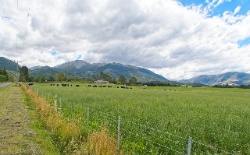'Extinct' seabird drops in for dinner
7 November 2005
‘Extinct’ seabird drops in for dinner
A small seabird known only from specimens collected over 150 years ago flew inside a fisherman’s boat anchored off Little Barrier Island on Friday night.
The bird is thought to be the New Zealand storm petrel (Oceanites maorianus), which was re-discovered nearly two years ago when it was photographed off Whitianga and Little Barrier or Hauturu.
Fisherman Geordie Murman and his crew were sitting down to a lasagne dinner on Friday night when the small black and white bird flew into the cabin. Having worked with seabirds before, Mr Murman realised it could be the elusive storm petrel that scientists had been seeking, and put it in a box.
Next morning Department of Conservation island biodiversity manager Richard Griffiths and Karen Baird of Kiwi Wildlife Tours identified the petrel as the same bird that had been photographed in 2003. They took notes and measurements, as well as feather samples for DNA analysis, before releasing the bird.
Mr Griffiths said it was a miracle the petrel had landed on Geordie Murman’s boat, who was one of the few people who would have been able to recognise it. The capture was very exciting and could lead to the bird being confirmed as the once presumed extinct New Zealand storm petrel, he said.
“If the DNA matches up then we’ve got a bird that people had believed to be extinct for over 100 years. It’s as significant as the rediscovery of the takahe.”
“For two years we’ve been trying to discover where it was breeding. We now think it is likely to be nesting on the Mokohinau Islands or another pest free island in the outer Hauraki Gulf.”
A louse specimen found on the bird is also of interest said Mr Griffiths. “Seabird lice tend to be host specific so we may have found an entirely new species.”
DNA from the bird will be compared with that taken from skins of New Zealand storm petrels caught in the 1800s. Only three skin specimens remain in museums in London and Paris.
A DNA sample was crucial for scientific confirmation of the species, said Mr Griffiths. The rare birds committee of the New Zealand Ornithological Society had failed to be convinced by digital photos taken of the storm petrels off Little Barrier and had requested more evidence.
The New Zealand storm petrel was first re-sighted by New Zealander Brent Stephenson off Whitianga in January 2003. Later that year two British ornithologists saw a small flock of the petrels off Little Barrier. Since then bird watchers and DOC staff have made a number of trips aboard the ‘Assassin’, skippered by Brett Rather, to attempt to catch one of the petrels and discover where they are breeding.
The storm petrel is about 20 cm long and is black and white with black streaks on the belly. It feeds at sea at night and returns to land only to breed.
ENDS


 Citizens of the Sea: Sailors To Revolutionise Our Understanding Of Pacific Biodiversity
Citizens of the Sea: Sailors To Revolutionise Our Understanding Of Pacific Biodiversity Netsafe: Making A Splash With Online Safety: Netsafe Launches New Flagship Programme For Kids
Netsafe: Making A Splash With Online Safety: Netsafe Launches New Flagship Programme For Kids NZGBC: Flood Resilience PhD Student Widi Auliagisni Named Future Thinker Of The Year 2024
NZGBC: Flood Resilience PhD Student Widi Auliagisni Named Future Thinker Of The Year 2024 Business Canterbury: European Free Trade Agreement A Game-changer For Canterbury
Business Canterbury: European Free Trade Agreement A Game-changer For Canterbury Business Canterbury: Urges Council To Cut Costs, Not Ambition For City
Business Canterbury: Urges Council To Cut Costs, Not Ambition For City Wellington Airport: On Track For Net Zero Emissions By 2028
Wellington Airport: On Track For Net Zero Emissions By 2028



